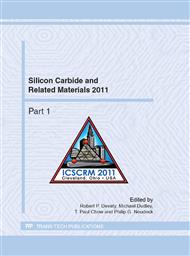p.533
p.537
p.541
p.545
p.549
p.553
p.557
p.561
p.565
Radiation Hardness of Wide-Bandgap Materials as Exemplified by SiC Nuclear Radiation Detectors
Abstract:
Polarization effect characteristically occurs in detectors based on wide-bandgap materials at considerable concentrations of radiation defects. The appearance of an electromotive force in the bulk of a detector is due to the long-term capture of carriers at deep levels related to radiation centers. The kinetics and strength of the polarization field have been determined. The capture can be controlled by varying the detector temperature, with a compromise reached at the "optimal" temperature between the generation current and the position of the deepest of the levels whose contribution to the loss of charge via capture is negligible. It has been found that the depth of a level (related to the energy gap width) is close to 1/3, irrespective of a material. The optimal temperatures are strictly individual for materials.
Info:
Periodical:
Pages:
549-552
Citation:
Online since:
May 2012
Price:
Сopyright:
© 2012 Trans Tech Publications Ltd. All Rights Reserved
Share:
Citation:


